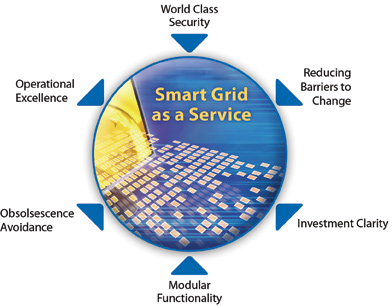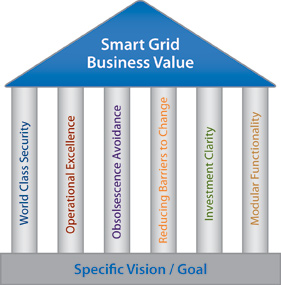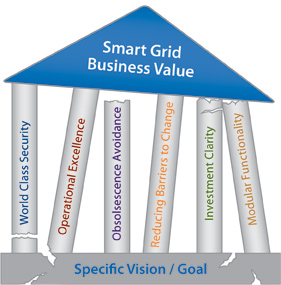Building a smarter grid is difficult. It is never an easy undertaking when a utility, large or small, is faced with making major investment decisions, especially when they can represent a similar order of magnitude as would be required for building a new power plant or transmission line. The process of selecting and implementing smart grid technology solutions can be quite a risky venture. This is especially true because technology is expected to impact all facets of a utility's business for the next 15 to 20 years.
The burning platform – A catalyst for change
Deciding on a course of action, given an organization’s specific set of financial circumstances, current technology investments, and strategic business requirements, can only make the process more complex. Are we moving too fast? Are we moving too slowly? Is the market mature? Will it ever be mature? How can we invest today in something that is constantly changing and evolving? How can I manage the risk to my operations and enterprise?
Smart grid is hard because it blends so many disparate parts of an organization together and forces utilities to excel in each of these areas. Many utility leaders have boldly invested in these changes, and a wealth of experience and lessons are available from their investments, actions, trials, and tribulations. Based on these experiences, different approaches are being considered to the traditional version of asset ownership and deployment.
Challenges to success – Where it gets difficult
Smart grid is often described as a set of new technologies deployed over transmission and distribution systems. While any smart grid deployment likely includes new assets and technologies, challenges often arise for smart grid when those new technologies need to be integrated into the business, supported by IT and operations, and operated efficiently enough to deliver the benefits promised. With limited budgets, challenging business cases, and a need to focus on existing operations, integrating new technologies into operations often takes a backseat to asset deployment, thus limiting the value programs are able to deliver. Utilities end up with infrastructure but lack the ability to develop the benefits to be derived from integrating that infrastructure into the business.
Those who are implementing smart grid successfully – with or without DOE funds and moving beyond simply introducing new assets and technologies – are able to address a set of key challenges within their operations. Without tackling these areas, smart grid fails to move from technology to business transformation. A number of the key challenges are explored below.
Security: Utilities need to apply world-class security capabilities across the technical, operational, and management security domains. While there is no smart grid security “standard,” there are industry guidelines and best practices that need to be intelligently applied. Since security excellence and extensive risk management often have a particularly poor business case, utilities need to make sure they are maximizing their ability to efficiently manage risk in the investments they make. Critically, utilities need to know how much security is “enough” in a world of evolving and expanding security risk, impact, and probability. Security design is one dimension, but integrating smart grid into security operations and lifecycle risk management is ultimately a critical dimension successful utilities need to be able to address. In addition, security must be executed in concert with North American Electric Reliability Corporation Critical Infrastructure Protection (NERC-CIP) and other potential regulatory and compliance mandates.
Operational Excellence: Utilities need to operate investments as an example of operational maturity and excellence across the people, processes (well documented and demonstrable), tools, and technologies involved. Otherwise, it is a constant challenge to derive the value and benefits out of the solution. Many utilities focus too heavily on the capital assets and installation, instead of the operational tools or, critically, the people required to operate effectively, securely, and efficiently. Successful utilities understand the need to “plan for excellence” in operating new services and in enabling technologies.
Obsolescence Avoidance: Most utilities need to make their investments count. Today, the lifespan of new assets needs to be long enough to recoup the costs and deliver the benefits, without breaking the bank. More importantly, they need to know that they can enter the “smart grid” universe at a comfortable and accessible entry point and grow into their future once they understand the value better. Successful utilities have confidence that their up-front investments will deliver business benefits as well as lead to the next logical step down the evolutionary road.
Modular Functionality: Utilities should enable the functionality that supports their business case; not everything the manufacturer offers. They need to be able to select the functions that have a meaningful impact to them and grow as their needs grow, rather than buying everything up front. That’s where budgets get eroded. Successful utilities are able to avoid the trap of buying everything today, at too high a cost, and having nothing left to integrate smart grid into their business operations.
Investment Clarity: Utilities need a full understanding of solution and capability costs as well as the risks; not just another set of unknowns. Utilities need to be able to represent the full lifecycle costs of the people, processes, and tools involved with smart grid so they can develop a complete cost perspective. Successful utilities maintain a clear understanding of cost and benefits and are able to reduce their need for ongoing pilots and test systems.
Reducing Barriers to Change: Utilities also need to focus on their core mission and not on a continuous set of enabling infrastructure distractions. Successful utilities are more likely to focus on leveraging actionable intelligence and information as opposed to exhausting their energy on designing and building the assets and communications that supply data.
In the end, the utilities that succeed in smart grid are those that focus on their core missions and augment their operations through smart grid value. Those who have invested, but failed to derive the perceived value in smart grid thus far have frequently gotten overwhelmed with the distractions and externalities that the enabling assets and technologies create.
How Smart Grid as a Service is helping
Successful utilities deploying smart grid should be able to address these challenges, but few are able to do so on their own. An increasing number of utilities are looking at procuring services instead of building out custom capital assets. More and more utilities are finding a better business case and investment justification through externalizing some dimensions of the “net new” infrastructure. Smart Grid as a Service, a key focus and offering of SAIC, can provide more certainty, clarity, and value through addressing some of these significant core challenges.

Figure 1: Smart Grid as a Service Value
Security. Smart Grid as a Service provides real, responsible, and defensible security, applied throughout deployed assets and their ongoing operations. Many utilities get pressed on business cases and agree to too much risk in order to make the numbers work. Smart Grid as a Service can make strong and lasting security investments and distribute the costs across clients. Meaningful security is an intimate process of identifying, measuring, and managing risk. Smart Grid as a Service can also accelerate organizations’ abilities to identify and manage risk in a meaningful way, without having to reinvent the wheel.
Operational excellence. Many utilities operate their technology investments on an ad-hoc basis. One of the most challenging aspects of smart grid can be investing in and maturing IT systems often seen as a cost center, not a core business area. Smart Grid as a Service can bring out-of-the-box operational maturity and excellence that allow utilities to start realizing benefits immediately. No more roadmaps to maturing IT in order to start smart grid; Smart Grid as a Service allows utilities to take big steps forward in maturing their business right out of the gate.
Modular functionality. Most advanced metering infrastructure and smart grid solutions are “all in.” You get all the functionality of a platform, at all the price. Smart Grid as a Service allows utilities to buy only what they need − no more, no less. This approach allows utilities to start wherever they are, wherever makes sense and to grow incrementally as their needs and business cases allow. Utilities can take this approach and have faith that their investment will meet service level agreements (SLAs) throughout the operational lifecycle.
Investment clarity. How much is it going to cost ultimately? What does a fully burdened operational lifecycle cost? Most utilities get stuck in continuous pilots working to discover benefits, and more importantly, a real idea of costs. Smart Grid as a Service can abbreviate or remove the pilot phase by providing clear functionality, service levels, and costs throughout the service’s lifespan. Smart Grid as a Service can provide clear benefits, clear costs, and often times, clear catalysts for change, without the uncertainty of people, processes, and tools that go along with it.
Reducing the barriers to change. Even in the best climates, absorbing significant operational and technological change can be a real risk to daily operations and focus. Most utilities have a need for operationally actionable intelligence and enterprise functionality, but the risks of transforming themselves into an IT company prevent them from achieving that functionality. Smart Grid as a Service is allowing utilities to externalize the technological distractions and focus on improving core operations through dependable mission critical smart grid intelligence.
Smart grid as a Service reduces the utility’s challenges associated with IT, but does not confuse IT with energy operations. Smart Grid as a Service providers need to be much more than IT operators or telecoms organizations. They need to bring experienced system operations and planning: an ability to bridge IT and operational technologies and an ability to translate technology into value and value into services. Smart Grid as a Service addresses IT challenges in a mature and focused manner, but needs to address much more than just IT in order to truly help utilities transform and mature.
Smart Grid as a Service versus do-it-yourself smart grid
In a world where “fit for purpose” solutions such as Smart Grid as a Service exist, the traditional smart grid project can be considered a “do-it-yourself” project. Smart Grid as a Service resembles do-it-yourself projects in many ways, but maintains important differences by primarily shifting the focus from assets and enabling technology to business value and operational investments. The goal of Smart Grid as a Service is fundamentally to provide defined functionality at consistent SLAs and metrics. With this goal in mind, Smart Grid as a Service allows utilities to worry less about specific technologies, for example the subtle differences in radio transmitters, and more about consistently providing the business justified value. Smart Grid as a Service concentrates on delivering benefits to organizations, period.
Smart Grid as a Service has many of the same components and functions as do-it-yourself solutions. For example, in advanced metering infrastructure approaches it includes meters, in-home assets, ZigBee, wireless systems, head-end control platforms, enterprise services buses, meter data management systems, analytics platforms, etc. Additionally, in advanced distribution operation systems, Smart Grid as a Service includes sensors and communication systems for collecting feeder data, state estimation tools for validating data, and analysis platforms for developing and distributing actionable information about system optimizations to reduce costs and improve service. The material difference between Smart Grid as a Service and do-it-yourself is in who designs, builds, operates, and owns the infrastructures, services, and performance requirements. Do-it-yourself investments leave all of that on the operator. Smart Grid as a Service investments make practical choices about where investment and ownership should reside.
Obsolescence avoidance. Most utilities can’t afford constant new capital investments. They need to select the right ones and make them count. In an emerging landscape of constant change like smart grid, selecting the right technologies and platforms for today and tomorrow can be a challenge. Smart Grid as a Service providers aren’t tied to individual vendors, technologies, or solutions. They have the ability to take a best-of-breed approach and are constantly motivated to do so in order to bring leading-edge capabilities to utility businesses. As a result, Smart Grid as a Service helps externalize the obsolescence risk.


Figure 2: Overcoming the Six Fundamental Challenges to Smart Grid
What Smart Grid as a Service is NOT is an endless distraction of technology choices. Smart Grid as a Service operators pick the technologies that can deliver benefits, achieve operational excellence, demonstrate exceptional security, and deliver functionality at or above defined service levels. Smart Grid as a Service is pre-integrated across technologies and operations, leaving organizations able to focus on matching function and value to each utility’s mission, culture, scope, and business case.
Moreover, Smart Grid as a Service customers don’t have to choose a service-oriented architecture and enterprise service bus solution, if indeed they need the latter. They don’t have to perform vendor test implementations and test-beds, or spend years evaluating competing technologies. Smart Grid as a Service customers buy solutions that are designed and delivered to perform to expectations around quality, security, efficiency, and efficacy.
Smart Grid as a Service begins in the design phase where business and benefits cases are defined and understood. Requirements are developed and specifics around territory, geography, consumer breakdown, financials, and business process are all mapped in order to determine “what success looks like” at that particular utility. Once requirements are understood, the relevant components from a Smart Grid as a Service portfolio are matched in order to deliver the scope of functionality at the service levels required. In the build phase, meters will need to be deployed, communications systems deployed and optimized, and business process transformed.
In do-it-yourself projects, hosting and datacenters need to be transformed or created; disaster recovery and business continuity plans need to be extended; investments in power and cabling need to be made; and talent needs to manage the deployment in perpetuity. Smart Grid as a Service projects on the other hand have the back-office transformation completed in the cloud without the need for the people, the processes, and the breadth of tools to monitor, measure, and report on each component or the services built on top of them. Do-it-yourself investments need to build the tools required to monitor and maintain security, 24/7. Smart Grid as a Service can leverage existing and mature solutions already deployed across the breadth of energy and utility security control catalogs and best practices.
In the operations phase, the two approaches diverge significantly again. Do-it-yourself programs now need to transform their organizations into mature, aggressive, and leading edge IT shops. Focus needs to move from utility core missions to IT lifecycles and operational maturity. Staffs must be identified, trained, and then retained in a booming labor market. Conversely, Smart Grid as a Service clients manage their vendors and monitor that their “net new” infrastructure performs. It also allows the utility to continue to deliver their core mission: reliable and safe energy to consumers. Critically, Smart Grid as a Service clients are now able to focus on their core missions with the aid of smart grid capabilities, but can do so without the distraction of an IT and security shop growing beyond expectations, desires, and identified budgets.
Conclusion
Smart Grid as a Service certainly isn’t for everyone. Some utilities are already too far down the path to take a different approach. Some have already made the difficult internal investments required to transform themselves into nimble, effective, and mature IT and security operations that get the most out of their investments. However, for those who seek to maintain focus on core functions and staff, and are looking for a more rapid, fit-for-purpose, and cost-effective smart grid transformation, Smart Grid as a Service has begun to catch the attention of cost-conscious and focused utilities. Instead of utilities becoming large IT organizations, some utilities are choosing to focus on their core mission, and engaging partners whose core mission is operational excellence in smart grid critical infrastructure operations and security.
About the Authors

Tom Damon is vice president of Leidos' (formerly SAIC) Smart Grid Solutions. He has spent more than 27 years assisting utilities with developing strategies and tactical requirements pertaining to workforce automation technology selections; process change management; and systems integration options and their impact on people, data, and technology management in solving business process issues for electric, gas, and water utilities. He has experience at all phases of the technology solution delivery cycle, including business case development, business and technology use case requirements, cost/ benefit and gap/feasibility analysis, executive briefings, and project management from conception to fully functional deployment. Mr. Damon also has experience with systems integration for creating the smart grid, including advanced metering infrastructure, advanced distribution and transmission operations, demand response, direct load control, home area networks, meter data management, outage management, geospatial information, distribution automation, and business intelligence implementations for the utility industry.

Josh Wepman is an assistant vice president of Leidos' (formerly SAIC) Smart Grid Solutions and works as the manager of the smart grid information technology and security group. Mr. Wepman also serves as the practice lead for Leidos' (formerly SAIC) Smart Grid and Critical Infrastructure Security consulting organization. Mr. Wepman brings seven years of energy and critical infrastructure experience from numerous oil and gas and utility operations. His present work includes developing and delivering security programs across the Nuclear Regulatory Commission and North American Electric Reliability Corporation compliance programs, as well as organizational risk management support for smart grid transformation programs. He also focuses on integrated, secure operations systems. Mr. Wepman is a graduate of the Michigan State University School of Communication Arts & Sciences, Department of Telecommunication Information Studies and Media.







